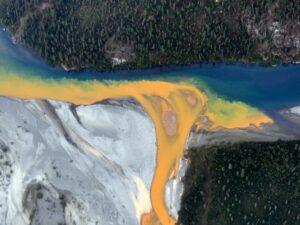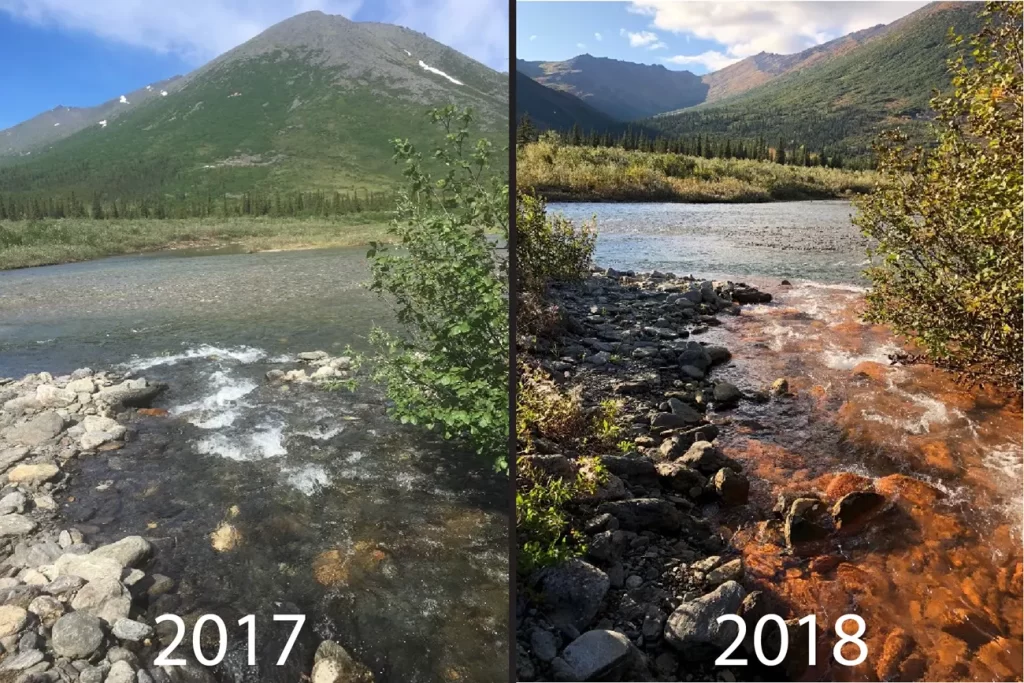Physical Address
23,24,25 & 26, 2nd Floor, Software Technology Park India, Opp: Garware Stadium,MIDC, Chikalthana, Aurangabad, Maharashtra – 431001 India
Physical Address
23,24,25 & 26, 2nd Floor, Software Technology Park India, Opp: Garware Stadium,MIDC, Chikalthana, Aurangabad, Maharashtra – 431001 India

Alaska’s rivers are turning bright orange and as acidic as vinegar due to toxic metals being released from melting permafrost. This contamination, visible from space, is expected to worsen over time.
A recent study has brought to light a startling transformation in dozens of Alaskan rivers. The once clear waters have turned a vivid orange, a result of toxic metals being released from melting permafrost. This alarming change, visible from space, is not a distant future scenario, but a pressing ecological threat that is rapidly intensifying.
The study, published on May 20 in the journal Communications Earth & Environment, identified at least 75 orange rivers and streams in a Texas-sized area of Alaska’s Brooks Range.

This phenomenon was first observed in 2018 when researchers noticed the milky orange rivers in northern Alaska’s Brooks Range, contrasting with the clear waters seen the previous year. Many contaminated waterways were initially spotted during helicopter surveys.

The consequences of this environmental shift are already devastating. Within a year, two fish species—the dolly varden and the slimy sculpin—were completely lost in a tributary of the Akillik River in Kobuk Valley National Park. This loss of biodiversity is a stark reminder of the urgent need for action.
Chemical analysis revealed high levels of zinc, nickel, copper, cadmium, and iron, with iron responsible for the orange colour. Some smaller streams had a pH as low as 2.3, similar to lemon juice or vinegar, according to the US Geological Survey.
The affected habitats are not only visually altered but also highly toxic to most aquatic life. Researchers are particularly concerned about the impact on spawning fish, which could significantly affect US fisheries.
This rusting is a seasonal phenomenon, typically occurring in July and August when the soil is deeply thawed. Researchers at the National Park Service, US Geological Survey, and University of California Davis aim to understand the long-term implications of changing water chemistry in regions with continuous permafrost, including parts of Alaska, Canada, Russia, and Scandinavia.
The high metal concentration and acidity are linked to melting permafrost, a permanently frozen Arctic layer. As this ground thaws due to climate change, previously trapped minerals are exposed to rain, allowing metals to leach into streams that feed larger rivers.
References:
https://www.nature.com/articles/s43247-024-01446-z
Images: National Park Service
Banner Image: An aerial view of the Kutuk River in Alaska’s Gates of the Arctic National Park that looks like orange paint spilling into the clear blue water. (Ken Hill / National Park Service)
Comments are closed.
Fabulous even
Очень свежие новинки моды.
Абсолютно все события известнейших подуимов.
Модные дома, бренды, гедонизм.
Лучшее место для стильныех хайпбистов.
https://furluxury.ru/
xsKDfBSIjvEP